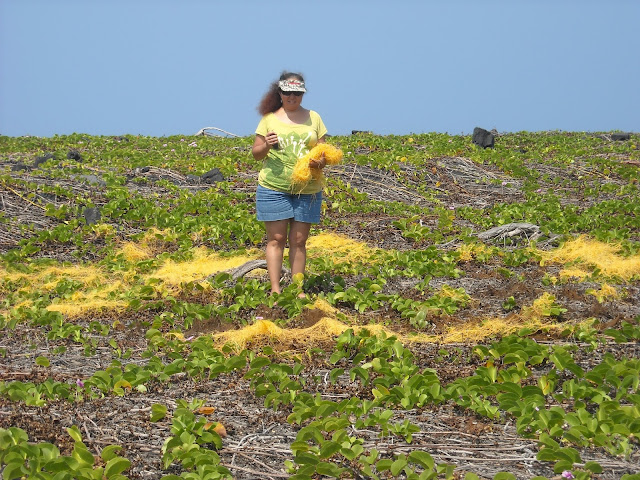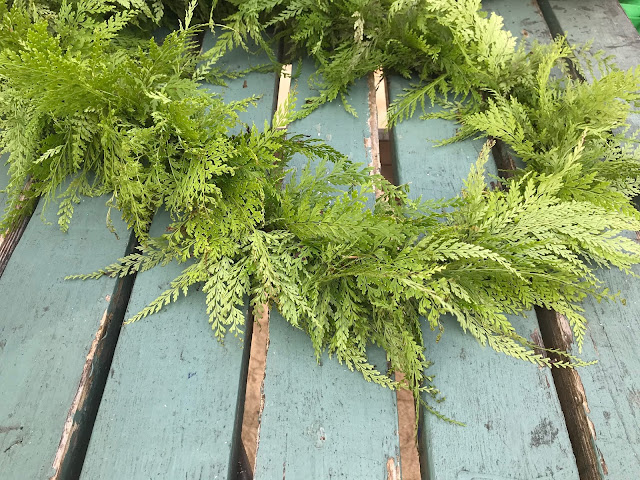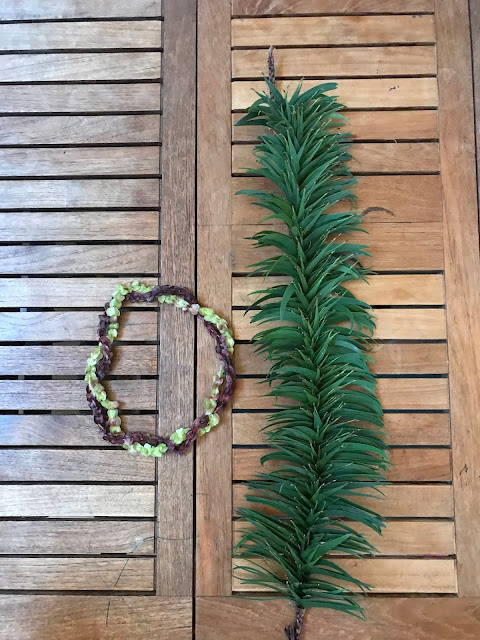One fun thing about these musings is that I hear from folks out of the blue. Thanking me, commenting, and offering insight and encouragement. When I press "Publish", off these words go into the ether. Iʻve no idea who reads them, or even if theyʻre read. But thatʻs beside the point. I do this because...it occupies some of my time, because I hope that it helps inform and maybe distract from quotidien concerns, but too, I love sharing bits of what Iʻve learned over the decades from my many generous mentors. Learning and passing along knowledge...Thatʻs it...
And here we are on Lei Day.
Of course this Lei Day, like all other days in these times, is...different physically, but the emotions of making, gifting, wearing lei remain. Iʻll be sharing a number of evocative photos from The Past. And they shall not include the purple dendrobium from Thailand or other SE Asian places. Those lei are shipped via air, premade, prepackaged, pre... they show up in big boxes at the LA Flower Mart and many many other places throughout the country.
Theyʻre used as an accessory, and Iʻd wager that most, whether giving or receiving, are clueless about the origin of their purple lei, much less the rich history of lei in Hawaiʻi and the Pacific. And the immensely sad thing is that those lei haole are here too. Uniform, handed out at meetings to speakers, to presenters, to whomever. Sad. Gone are the carnation farms on Maunalani Heights, the pikake of Kāhala and Puakō, rare are the ʻākulikuli and Chinese Lily of Waimea. Even our beloved maile is increasingly hard to come by.
Here a lei maile lau liʻiliʻi, a tiny-leafed variety from Kauaʻi, gifted by km...
Weʻve seen an inferior species, not as fragrant, flown in from Rarotonga, and more recently, imitation lei maile ingeniously fashioned from lāʻī (ti leaves). Good for creativity, but Auē for the lack of favorites. But such is economics, commercialism, and the trivialization of Hawaiʻi Nei and her cultures. I pray mightily that These Times serve as a wake up call.
OK. Having vented, now for the pretties... memory-prodding evocative pictures, our windows into a past getting dimmer with each passing day. We remember. What follows is a random assortment of Those Times...Lots of stories go with the photos, but for today, simple musings...
Marie McDonald must be acknowledged here. Marie died at 92, in August 2019. She and her daughter Roen were extremely influential in the world of lei. Roen and her friend Joyce Jacobsen taught me and many others leimaking in the old styles of wili, hili, haku, hīpuʻu, hilo, etc., during workshops at UH Mānoa in the early 70s.
 |
| Damon Tucker... photo by her daughter, Roen Hufford |
OK, Bob, letʻs move along...in no particular order...
Lei puakenikeni. The Ten Cent flower, because itʻs said thatʻs what each pua cost before. The flowers open ivory, next day theyʻre yellow, then the third day dark gold. Kāneʻohe on Oʻahu get plenny puakenikeni, but so does Hilo. It likes the wet.
From Sig this morning with Lei Day greetings:
And years ago for my lā hānau at our hula ʻauana Mākuanani class with Kumu Nālani, again, a SigSpecial...
Lei hulu (feather lei) have been cherished for centuries. Today theyʻre made of natural pheasant or rooster feathers, or dyed duck, goose, etc... This, a dyed lei hulu kāmoe, where the hulu lie flat or asleep.
Below, a lei hulu wili poepoe, with hulu curved outward. I saw this one at Lyman Museum in Hilo, perhaps of ʻōʻō, now extinct. Small bundles of feathers are tied to a central cordage core..
An ʻuo, a bundle of yellow ʻōʻō and red-orange ʻiʻiwi from Bishop Museum. These were used to fashion both lei as well as capes and cloaks. See the tie-end of the lei above? It has ʻiʻiwi too. The color of the pāʻū ʻiʻiwi (ʻiʻiwi skirt) likely symbolizes the aliʻi and their mana. Feathers are oh so small, and it appears that this ʻuo might be fastened with a strip of maiʻa (banana) trunk fiber.
The manu from which the yellow, rarest, hulu were obtained, from Bishop Museum. First the mamo, the rarest of all. The solid yellow ahuʻula (cloak) of Kamehameha is made of mamo.
And ʻōʻō. A bit less rich in color; more lemony. Though itʻs often said that birds were caught, two feathers plucked and the bird released, we can see that hulu are found in clumps. And there are references that the birds were sometimes eaten.
For those without access to precious and cherished lei hulu, we might use our endemic kaunaʻoa to perhaps emulate hulu. A delicate parasitic vine often found growing on pōhuehue (beach morning glory), it eventually kills its host and withers, but there always seems to be some popping up adjacent.
On the coast of Kona ʻAkau, hot, sometimes windy, and with often infrequent rain, it thrives.
And even in the wilds of areas adjacent to Washington DC, I found a closely related species!
Lei kaunaʻoa as above are twisted, much as lei lāʻī are made, in the hilo style, using a single material.
Below, also a one species lei, in the style hili, braided, using palaʻā. Lei palapalai are fashioned this way too.
And too, the stems of lau kukui can be carefully and precisely braided.
Below is braided lāʻī with lau kukui and lauaʻe inserted, for a lei lio, a lei for a horse, most often used in parades, such as during Kamehameha Day or Aloha Week.
Another lei haku, this one more reserved and delicate, using folded lau kukui and lau koa, braided into lāʻī.
Related to koa, but with lau that are more slender and sometimes with a purplish cast are lau koaia, the green lei below made as a lei hili koaia, next to two strands of lei kui ʻaʻaliʻi. Both by Kaleinohea. ʻAʻaliʻi pods strung, as we fashion lei plumeria, though lei kui ʻaʻaliʻi are WAY more time consuming, though of course that adds to their preciousness.
And Sig designed a lei hoaka print I fancied, and of course had to find a lei to go with...
Sometimes wahine want an adornment for their hair, rather than a full lei. A short kūpeʻe, more properly perhaps a bracelet or an anklet, but here a headlet, crafted of braided lāʻī, lauaʻe (the leaf-like fern), moa (the bumpy stems), and sweet buds of tiare. Mmmmm.
Or maybe a lei for their pāpale. These from Roen, braided palapalai with pansies, etc.
Might be kinda hard to discern, sitting as it is on a tray on the basin in the bathroom, but a lei haku with silvery lau paʻiniu, an endemic lily found up here in rain forest, palapalai, and the blues of pōpōhau, hydrangea, a favorite here in Volcano.
Alert ones will recognize this dazzler from a few posts ago. Lāʻī twisted hilo style then inserting pua kokio, a nearly extinct relative of hibiscus from Kona ʻAkau, cultivated by friends in their yard.
You know, sometimes people freak out...I need one lei! No moʻ! What I goinʻ do??? Ummm... Hows about make with what get? Look around and be creative. You can get kolomona from the shrubs in the pasture, roses from the ramshackle old homestead, liko from ʻōhiʻa trees, and if string is lacking, try some ʻilihau (hau fiber), or some kikuyu grass runners. GoTry!
If all get are lilla bit pua hala pepe from the tree in the yard, kui (string) them!
Or if you really stuck and get milo trees, go pick up the fallen-down wilted flowers and string them! Might be nice...
With a little more planning, go find cultivated endemic ʻōhai and kui them. Your favorite singer might surprise you with the serendipity of wearing an ʻōhai print! Ahhhh...
Something that demands advance planning... lei hala. Lots of work, blisters, calluses, but Uncle Roy Benham was among the best at cutting and designing lei hala...yellow are common; but the locations of pūhala (hala trees) with keys of reds and oranges are closely held secrets.
Whew! Getting carried away... Letʻs close with a lei pretty much anybody can make. All you need is a string of some sort. My go-to is ʻilihau, though others use nylon, raffia, cotton string, yarn, a skinny piece of sheet, whatever... Oh. And the flowers. Kou. Theyʻre unscented, but because I love their orange ruffles, theyʻre beauties. And kou is both native and a Polynesian introduction. Itʻs been widely planted because it grows quickly and fulfills landscape-with-native-plants requirements. But seed pods are dangerously spherical. Be careful!
 |
| Flickr: David Eickhoff |
I know, I know...Bananas. At the beach. But we werenʻt fishing...
I love a parade!!!
Below: me with kou, HK with lei kukui...
Post-Parading... We miss Naiʻa...
Go. Make. Lei. Give away, wear. Put good energy into them. Donʻt try to save them for tomorrow, or be concerned that the weathers will wilt them. Bestow them with aloha. Enjoy and appreciate them in the moment, understanding the time, energy, patience, and love that are part of their creation. Donʻt put them in the trash. Let them return to the earth.
As always, with aloha,
BobbyC
maniniowali@gmail.com



































No comments:
Post a Comment